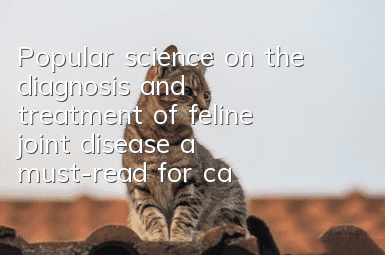Popular science on the diagnosis and treatment of feline joint disease, a must-read for cat owners!

Are elderly cats susceptible to joint disease?
Popular science on the diagnosis and treatment of cat arthrosis, a must-read for cat owners! Arthritis is a chronic disease, which may not be of much concern to the owner in the early stage. Occasionally, he does not like to exercise or walks. Abnormalities are often ignored, but if the abnormality is really caused by joint disease, it may not be easy to treat when it is really noticed. Of course, the joints not only affect the cat’s walking posture, but may also cause a series of functional disorders. .
Some people think that the probability of cat joint disease is very small and generally does not occur. In fact, this statement is one-sided. For young cats, they may not be affected by joint disease if they are strong and healthy. trouble, but scientific research has found that 30% of cats over eight years old are suffering from pain caused by arthritis, so sometimes the limp of elderly cats cannot be taken for granted, despite aging There are many aspects of the body’s performance, but if you really care about your cat’s health, it’s better to get it checked out.
There is no doubt that there are many causes of joint disease, such as nutrition metabolism, inflammation caused by trauma, etc., and the degree of joint disease caused by different causes is different, some are just lame, and some are just lame. may become paralyzed. Take degenerative joint disease in cats as an example. This is a relatively mild joint disease. Although it is less likely to occur in cats, it should not be underestimated.
1. Symptoms
Phasic or persistent lameness and unwillingness to move. Lameness improves during activity; claudication worsens after strenuous activity, especially after a period of rest. The frequency and severity of pain and claudication increase as the disease progresses. The joints are not flexible, there is pain during movement and palpation, and the joints are swollen with effusion.
2. Diagnosis
Usually based on medical history, clinical examination results and characteristic X-ray signs. Clinical examination may reveal pain in the affected joints, reduced range of joint motion, crepitus when extending and flexing the joints, and (possibly) joint swelling. The key to identifying pain in your cat is to check for changes in his or her lifestyle, which are often caused by mobility issues and may include a reluctance to jump or an inability to jump as high as before, as well as a decrease in the cat's overall activity level, such as being more lethargic. , and played less.
3. Treatment
(1) Limiting activities or regularly spaced activities can control clinical symptoms.
(2) Apply drug treatment to alleviate clinical symptoms:
①Aspirin, 10-25 mg/kg, orally, 2-3 times a day;
② Chlorcarbazole propionate, 2.2 mg/kg, taken orally, twice a day; phenylbutazone, 13 mg/kg, taken orally, 2-3 times a day, up to 800 mg a day, not for cats;
③Corticosteroids such as prednisone, 1-2mg/kg, oral,2-3 times a day, gradually reduce to 0.25mg/kg. While using the above drugs, give cimetidine, 5-10 mg/kg, orally, 3 times a day to prevent gastric ulcers.
(3) Surgical treatment: Joint replacement or arthroplasty can effectively reduce pain and restore limb function.
In addition, some unique methods can also be used to treat cat arthrosis, such as hydrotherapy. In California, USA, a 14-year-old domestic cat named Morph suffers from arthritis. His owner Jo Scott He was sent to a spa center on the south coast of California. The principle of hydrotherapy is not complicated. The buoyancy of water can relieve the pressure on muscles and bones, allowing the limbs of small animals to move freely in the water without being affected by pressure. This can exercise the limbs. Flexibility, and can promote blood circulation in the body, and has a therapeutic and preventive effect on inflammation. At first, Morph was afraid of water like other cats, but after careful care by the staff, Morph enjoyed the warm water temperature here and loved the close contact with people.
- How often does a cat need to brush its teeth?
- How to train a Canadian hairless cat not to bite
- The pros and cons of neutering female cats
- Can kittens eat probiotics if they have diarrhea?
- British Shorthair has sparse hair above his eyes
- Will saline irritate cats' eyes?
- How long can a cat survive with blood clots?
- Can cats eat salt?
- What are the symptoms of a cold in cats?
- What to do if a kitten’s eyes bleed with pus



